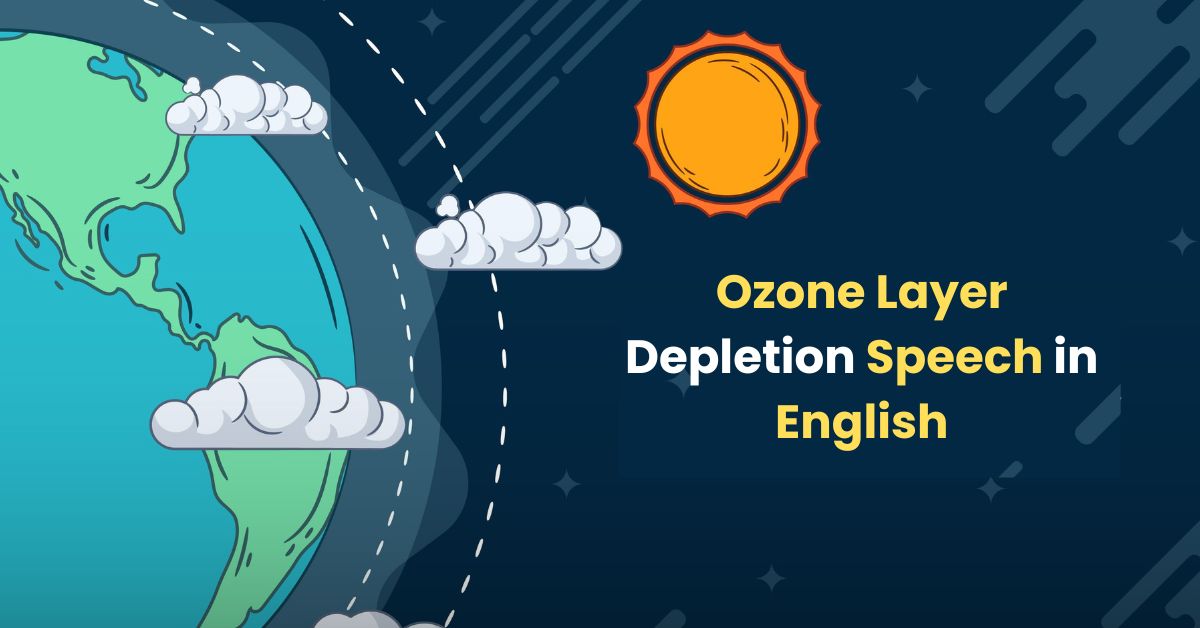Good morning respected teachers, fellow students, and esteemed guests,
Ozone Layer Depletion Speech in English: Today, I stand before you to talk about something that affects not just our country, but every single living being on this planet Ozone Layer Depletion.
Ozone Layer Depletion Speech in English
The ozone layer is like Earth’s sunscreen. It’s a thin shield in our atmosphere, protecting us from the sun’s harmful ultraviolet (UV) rays. Without it, life on Earth would be drastically different, and possibly, even impossible. Yet, over the past few decades, this life-saving layer has been deteriorating, primarily because of human activities. And what’s truly alarming is that we are the ones responsible for putting our future at risk.
But what exactly is causing this depletion? The main culprit is a group of chemicals known as CFCs Chlorofluorocarbons. They were once widely used in refrigerators, air conditioners, and aerosol sprays. When released into the atmosphere, these chemicals break down the ozone molecules, leaving gaps and thinning the layer. As a result, more harmful UV rays reach Earth’s surface, leading to severe consequences.
The effects of ozone layer depletion are terrifying. Increased exposure to UV rays can cause skin cancer, cataracts, and weaken our immune systems. But it doesn’t stop there. Our environment suffers too. UV rays disrupt ecosystems, harm marine life, and stunt the growth of crops that feed millions of people. This is a chain reaction, and it’s frightening to realize that our future is so closely tied to the health of this invisible shield above us.
You might ask, What can we do? Thankfully, not all hope is lost. One of the most significant steps humanity has taken is the Montreal Protocol, an international agreement signed in 1987 to phase out the production of CFCs and other ozone-depleting substances. This collective action by countries worldwide has shown promising results. In fact, experts predict that if we continue on this path, the ozone layer could fully recover by the middle of this century.
But we must not become complacent. Our role as individuals is crucial. Simple actions, like choosing products that are ozone-friendly, reducing our carbon footprint, and spreading awareness about this issue, can make a world of difference. We, the younger generation, have a responsibility to protect our planet for ourselves and future generations.
In conclusion, let us remember that the ozone layer is not just an atmospheric layer; it is our protector. We must continue to fight for its recovery, and in doing so, we are fighting for a safer, healthier, and more sustainable future for all living beings on Earth.
Let’s be the generation that heals the damage, not the one that ignores it. Thank you.
FAQs: Ozone Layer Depletion Speech in English
1. What is the ozone layer, and why is it important?
The ozone layer is a thin shield of ozone gas located in the Earth’s stratosphere. It protects us from the sun’s harmful ultraviolet (UV) rays, which can cause skin cancer, cataracts, and other health problems. Without this layer, life on Earth would face severe consequences. It’s like the Earth’s natural sunscreen, protecting everything under it.
2. What causes the depletion of the ozone layer?
The main cause of ozone depletion is human-made chemicals, especially Chlorofluorocarbons (CFCs). These chemicals, once used in refrigerators, air conditioners, and aerosol sprays, break down the ozone molecules when they reach the stratosphere, creating holes and thinning the layer. It’s heartbreaking to think that something we once used in everyday life is now causing so much damage to our planet.
3. How does ozone depletion affect humans and the environment?
Ozone depletion allows more UV rays to reach Earth, leading to an increased risk of skin cancer, cataracts, and a weakened immune system. But the damage isn’t just limited to humans. UV rays harm marine ecosystems, plankton, and crops, threatening the very food we rely on. It’s a ripple effect that spreads across every part of our planet. Knowing that our actions have caused such widespread harm should make us think twice about how we treat the Earth.
4. Is the ozone layer still depleting?
Thanks to global efforts like the Montreal Protocol, the depletion has slowed down. This international agreement phased out CFCs and other harmful substances. While this has led to some recovery, the ozone layer is still fragile and far from fully healed. The progress is encouraging, but we must continue to act responsibly to ensure the ozone layer recovers completely.
5. What can we do to help protect the ozone layer?
Every action counts. We can use ozone-friendly products, avoid aerosols with harmful chemicals, reduce our carbon footprint, and raise awareness about ozone depletion. Choosing a more sustainable lifestyle shows that we care not just for ourselves, but for future generations. We have the power to make a difference, and it’s time to step up and protect our home.
6. How long will it take for the ozone layer to recover?
Scientists estimate that if we continue on the current path of reducing harmful emissions, the ozone layer could fully recover by the mid-21st century. That’s within our lifetimes! But it won’t happen without continued global effort. Knowing that we can make a real impact should inspire us to keep pushing for change.
7. How does climate change relate to ozone depletion?
Both issues are closely linked. Some ozone-depleting chemicals are also greenhouse gases, which contribute to global warming. Climate change also affects the ozone layer’s recovery by altering atmospheric conditions. This shows how interconnected our planet is; what harms one part inevitably affects another. Understanding this connection makes it clear that solving one issue can help address the other.






1 thought on “Ozone Layer Depletion Speech in English”